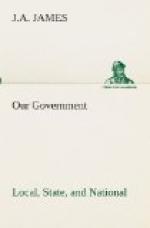Relations between Territories and Congress.—A Territory is organized by an Act of Congress which provides for these officers and prescribes their powers. The Territorial legislature controls the internal affairs of the Territory; but its acts may be changed or vetoed by Congress. The people of a Territory have no voice in National affairs, but they elect a delegate to Congress, who may debate but not vote.
Porto Rico.—The government of Porto Rico is different at some points from that of the other organized Territories. The upper house of its legislature is the Executive Council and consists of the administrative officers of the Territory (secretary, treasurer, auditor, commissioner of the interior, attorney-general, and commissioner of education) and five other persons appointed by the President. Five of the eleven members of this council must be natives of Porto Rico. The House of Delegates has thirty-five members, elected triennially by the voters. There is elected by the people a “resident commissioner” to the United States, who, unlike the delegates from other Territories, has no seat in Congress, but rather has official relations with the President.
The Territory of Hawaii.—Hawaii was annexed to the United States in 1898, and its government was established by Congress in 1900. The administrative officers in this Territory are appointed by the governor, instead of by the President. Voters in Hawaii must be able to read and write either the English or Hawaiian language.
Alaska.—By
a law of 1912, Alaska was given for the first time
a Territorial legislature,
consisting of two houses, elected by the
people.
Our Government in the Philippine Islands.—The Philippines constitute the largest part of “our insular possessions,” and are not classed as Territories. The word “colonies” better expresses their relations to the United States. They are governed by a commission of nine members: the governor, four heads of departments (Americans), and four Filipinos. All are appointed by the President with the consent of the Senate. This commission constitutes the upper house of the legislative body; the lower house or assembly is elected from certain districts of the islands where the people are considered civilized and are at peace. Voters must be property-owners and be able to read and write English or Spanish.
The entire group of islands is divided into provinces. In some of these the people have local self-government; in others there is military government under the United States army. In many cities the government is similar to that of American cities.
Besides numerous other
small islands the United States possesses
Tutuila in the Samoan
group, Guam, and Wake Island. These are
governed directly by
the naval authorities of the government.
The Panama Canal Zone
is governed by the Isthmian Canal Commission,
consisting of seven
men appointed by the President. The commission
is subordinate to the
War Department at Washington.




